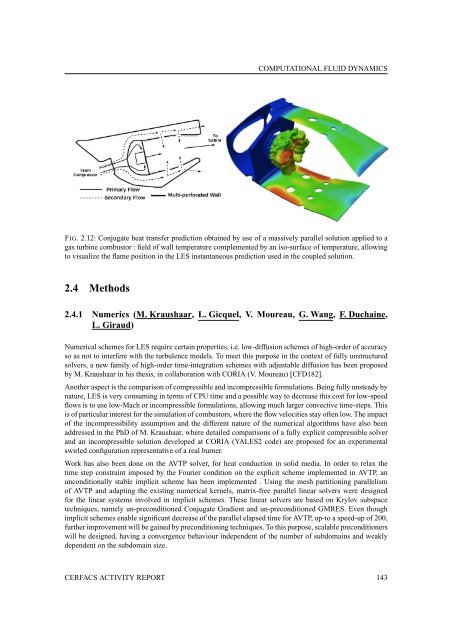CERFACS CERFACS Scientific Activity Report Jan. 2010 â Dec. 2011
CERFACS CERFACS Scientific Activity Report Jan. 2010 â Dec. 2011
CERFACS CERFACS Scientific Activity Report Jan. 2010 â Dec. 2011
Create successful ePaper yourself
Turn your PDF publications into a flip-book with our unique Google optimized e-Paper software.
COMPUTATIONAL FLUID DYNAMICS<br />
FIG. 2.12: Conjugate heat transfer prediction obtained by use of a massively parallel solution applied to a<br />
gas turbine combustor : field of wall temperature complemented by an iso-surface of temperature, allowing<br />
to visualize the flame position in the LES instantaneous prediction used in the coupled solution.<br />
2.4 Methods<br />
2.4.1 Numerics (M. Kraushaar, L. Gicquel, V. Moureau, G. Wang, F. Duchaine,<br />
L. Giraud)<br />
Numerical schemes for LES require certain properties, i.e. low-diffusion schemes of high-order of accuracy<br />
so as not to interfere with the turbulence models. To meet this purpose in the context of fully unstructured<br />
solvers, a new family of high-order time-integration schemes with adjustable diffusion has been proposed<br />
by M. Kraushaar in his thesis, in collaboration with CORIA (V. Moureau) [CFD182].<br />
Another aspect is the comparison of compressible and incompressible formulations. Being fully unsteady by<br />
nature, LES is very consuming in terms of CPU time and a possible way to decrease this cost for low-speed<br />
flows is to use low-Mach or incompressible formulations, allowing much larger convective time-steps. This<br />
is of particular interest for the simulation of combustors, where the flow velocities stay often low. The impact<br />
of the incompressibility assumption and the different nature of the numerical algorithms have also been<br />
addressed in the PhD of M. Kraushaar, where detailed comparisons of a fully explicit compressible solver<br />
and an incompressible solution developed at CORIA (YALES2 code) are proposed for an experimental<br />
swirled configuration representative of a real burner.<br />
Work has also been done on the AVTP solver, for heat conduction in solid media. In order to relax the<br />
time step constraint imposed by the Fourier condition on the explicit scheme implemented in AVTP, an<br />
unconditionally stable implicit scheme has been implemented . Using the mesh partitioning parallelism<br />
of AVTP and adapting the existing numerical kernels, matrix-free parallel linear solvers were designed<br />
for the linear systems involved in implicit schemes. These linear solvers are based on Krylov subspace<br />
techniques, namely un-preconditioned Conjugate Gradient and un-preconditioned GMRES. Even though<br />
implicit schemes enable significant decrease of the parallel elapsed time for AVTP, up-to a speed-up of 200,<br />
further improvement will be gained by preconditioning techniques. To this purpose, scalable preconditioners<br />
will be designed, having a convergence behaviour independent of the number of subdomains and weakly<br />
dependent on the subdomain size.<br />
<strong>CERFACS</strong> ACTIVITY REPORT 143
















